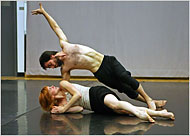 The NY Times recently reported a fascinating story about Gregg Mozgala, a 31-year-old actor with cerebral palsy, whose body movements were transformed after working with a choreographer for the past eight months. When he began, he walked “like ‘a human velociraptor,’ as he put it: up on his toes, lower extremities turned in, seesawing from side to side to maintain balance.”
The NY Times recently reported a fascinating story about Gregg Mozgala, a 31-year-old actor with cerebral palsy, whose body movements were transformed after working with a choreographer for the past eight months. When he began, he walked “like ‘a human velociraptor,’ as he put it: up on his toes, lower extremities turned in, seesawing from side to side to maintain balance.”
From the article:
They began doing intensive one-on-one sessions they call body work, Ms. Rogoff using her knowledge of the body and dance-training techniques to help Mr. Mozgala “find” individual bones, muscles and tendons that he had had no command of before. They started at the top and worked down — sternum, sacrum, knees — with Mr. Mozgala’s body and brain opening paths of communication that had not existed. “There’s a lot of howling, screaming, crying, sweating,” Ms. Rogoff said. But “we often have these huge eureka moments.”
The other day, for instance, it was brain, meet lower-leg tendon.
“I said today, ‘I can feel my Achilles,’ ” Mr. Mozgala said. “You have to realize, I have never felt my Achilles before.”
This is an exciting development for anyone with a neurological impairment, not just those with cerebral palsy. The changes were able to occur due to the neuroplastic quality of the brain – the ability to rewire and transform itself from moment to moment. Previously the neuronal circuitry was thought to be fixed; hardwired from birth. But in the last twenty years or so scientists discovered that the brain’s wiring is malleable and constantly changing.
“This isn’t a cure,” Mr. Mozgala said. “I’m always going to have cerebral palsy.”
But now he doesn’t feel so enslaved by it.
“Everybody told me there was nothing I could do,” he said. “That’s just what you hear, from the time you’re 5 to adulthood. Tamar gave me an option.”
Whether the methods they have used can translate to others remains to be seen. But Dr. Paget said their progress held a message for anyone with a neurological impairment.
“It’s not over,” he said. “There’s always a chance to change. You should not — you dare not — give up.”
Here is another good article on the story from aolhealth.com: Overcoming Cerebral Palsy










This is an amazing story….this topic of brain plasticity
keeps getting more interesting all the time! Thanks for posting this. I love seeing hopeful, true-life stories like this one. Perhaps someone would be interested in doing a video piece of brain retraining results in someone with MCS some day?
This is such an exciting and incredible story. I only wish more individuals affected with cerebral palsy recognized the benefits of brain plasticity. In my own profession, I help parents recognize the signs of cerebral palsy.